Multi-Scale Analysis of Spatial and Temporal Evolution of Carbon Emissions in Yangtze River Economic Belt and Study of Decoupling Effects
Abstract
:1. Introduction
2. Data Sources and Research Methodology
2.1. Study Area
2.2. Sources of Data
2.3. Research Methods
| Energy Type | Carbon Emission Coefficient | Energy Type | Carbon Emission Coefficient |
|---|---|---|---|
| raw coal | 0.7559 | crude oil | 0.5857 |
| refined coal | 0.7559 | petrol | 0.5538 |
| coke | 0.8550 | diesel | 0.5714 |
| coke oven gas | 0.3548 | diesel oil | 0.5921 |
| other gas | 0.3548 | fuel oil | 0.6185 |
| other coking products | 0.6449 | liquefied petroleum gas | 0.5042 |
| refinery dry gas | 0.4602 | other petroleum products | 0.5857 |
| petroleum | 0.4483 | electrical power | 0.2720 |
3. Characteristics of the Spatial and Temporal Evolution of Carbon Emissions at Different Scales
3.1. Provincial Scale
3.2. Municipal Scale
3.3. County Scale
3.4. Spatial Autocorrelation of Carbon Emissions
3.4.1. Global Spatial Autocorrelation
3.4.2. Local Spatial Autocorrelation
4. Decoupling of Carbon Emissions from Economic Development at Different Scales
4.1. Provincial Scale
4.2. Municipal Scale
4.3. County Scale
4.4. Spatial Autocorrelation of Carbon Decoupling Indices
| 2004–2010 | 2010–2015 | 2015–2020 | ||
|---|---|---|---|---|
| Moran’s I | −0.0642 | −0.0603 | 0.0239 | |
| Provincial | z | 0.5478 | 0.236 | 0.222 |
| p | 0.352 | 0.354 | 0.7258 | |
| Moran’s I | 0.1732 | 0.4134 | 0.4679 | |
| Municipal | z | 3.3059 | 7.5500 | 8.6374 |
| p | 0.001 | 0.001 | 0.001 | |
| Moran’s I | 0.0172 | 0.0827 | 0.0163 | |
| County | z | 2.0660 | 6.6354 | 1.2088 |
| p | 0.000 | 0.000 | 0.000 |
5. Conclusions and Discussion
5.1. Conclusions
5.2. Discussion
6. Policy Recommendations
Author Contributions
Funding
Data Availability Statement
Conflicts of Interest
References
- Thomas, C.D.; Cameron, A.; Green, R.E.; Bakkenes, M.; Beaumont, L.J.; Collingham, Y.C.; Erasmus, B.F.N.; de Siqueira, M.F.; Grainger, A.; Hannah, L.; et al. Extinction risk from climate change. Nature 2004, 427, 145–148. [Google Scholar] [CrossRef]
- Chen, J.G.; Crooks, R.M.; Seefeldt, L.C.; Bren, K.L.; Bullock, R.M.; Darensbourg, M.Y.; Holland, P.L.; Hoffman, B.; Janik, M.J.; Jones, A.K.; et al. Beyond fossil fuel–driven nitrogen transformations. Science 2018, 360, eaar6611. [Google Scholar] [CrossRef] [PubMed]
- Wise, M.; Calvin, K.; Thomson, A.; Clarke, L.; Bond-Lamberty, B.; Sands, R.; Smith, S.J.; Janetos, A.; Edmonds, J. Implications of Limiting CO2 Concentrations for Land Use and Energy. Science 2009, 324, 1183–1186. [Google Scholar] [CrossRef] [PubMed]
- Rehman, A.; Rauf, A.; Ahmad, M.; Chandio, A.A.; Deyuan, Z. The effect of carbon dioxide emission and the consumption of electrical energy, fossil fuel energy, and renewable energy, on economic performance: Evidence from Pakistan. Environ. Sci. Pollut. Res. 2019, 26, 21760–21773. [Google Scholar] [CrossRef] [PubMed]
- Liu, K.; Xue, M.; Peng, M.; Wang, C. Impact of spatial structure of urban agglomeration on carbon emissions: An analysis of the Shandong Peninsula, China. Technol. Forecast. Soc. Chang. 2020, 161, 120313. [Google Scholar] [CrossRef]
- Cui, S.; Wang, Y.; Xu, P.; Shi, Y.; Liu, C. Spatial-temporal multi-factor decomposition and two-dimensional decoupling analysis of China’s carbon emissions: From the perspective of whole process governance. Environ. Impact Assess. Rev. 2023, 103, 107291. [Google Scholar] [CrossRef]
- Wei, X.; Ma, Q.; Su, H. Spatiotemporal effect and influencing factors of the total factor energy efficiency: Evidence from the urban agglomerations in China. Ecol. Indic. 2024, 161, 111984. [Google Scholar] [CrossRef]
- Zhang, Z.; Luo, X.; Hu, H.; Du, J.; Xu, B. Market integration and urban air quality: Evidence from the Yangtze River Economic Belt of China. Econ. Anal. Policy 2023, 80, 910–928. [Google Scholar] [CrossRef]
- Wu, W.; Zhang, T.; Xie, X.; Huang, Z. Regional low carbon development pathways for the Yangtze River Delta region in China. Energy Policy 2021, 151, 112172. [Google Scholar] [CrossRef]
- Han, H.; Li, H.; Zhang, K. Spatial-Temporal Coupling Analysis of the Coordination between Urbanization and Water Ecosystem in the Yangtze River Economic Belt. Int. J. Environ. Res. Public Health 2019, 16, 3757. [Google Scholar] [CrossRef] [PubMed]
- Feng, Y.; Ning, M.; Lei, Y.; Sun, Y.; Liu, W.; Wang, J. Defending blue sky in China: Effectiveness of the “Air Pollution Prevention and Control Action Plan” on air quality improvements from 2013 to 2017. J. Environ. Manag. 2019, 252, 109603. [Google Scholar] [CrossRef] [PubMed]
- Yang, L.; Yang, Y.; Zhang, X.; Tang, K. Whether China’s industrial sectors make efforts to reduce CO2 emissions from production?A decomposed decoupling analysis. Energy 2018, 160, 796–809. [Google Scholar] [CrossRef]
- Jia, K.; Yuan, R. The impact of basin horizontal ecological compensation policies on carbon emissions: A case study of the Yangtze river economic Belt. Heliyon 2024, 10, e28858. [Google Scholar] [CrossRef] [PubMed]
- Liu, X.-J.; Jin, X.-B.; Luo, X.-L.; Zhou, Y.-K. Multi-scale variations and impact factors of carbon emission intensity in China. Sci. Total Environ. 2023, 857, 159403. [Google Scholar] [CrossRef] [PubMed]
- Luo, H.; Wang, C.; Li, C.; Meng, X.; Yang, X.; Tan, Q. Multi-scale carbon emission characterization and prediction based on land use and interpretable machine learning model: A case study of the Yangtze River Delta Region, China. Appl. Energy 2024, 360, 122819. [Google Scholar] [CrossRef]
- Zhou, K.; Yang, J.; Yin, H.; Ding, T. Multi-scenario reduction pathways and decoupling analysis of China’s sectoral carbon emissions. iScience 2023, 26, 108404. [Google Scholar] [CrossRef] [PubMed]
- Wei, M.; Cai, Z.; Song, Y.; Xu, J.; Lu, M. Spatiotemporal evolutionary characteristics and driving forces of carbon emissions in three Chinese urban agglomerations. Sustain. Cities Soc. 2024, 104, 105320. [Google Scholar] [CrossRef]
- Wang, Y.; Niu, Y.; Li, M.; Yu, Q.; Chen, W. Spatial structure and carbon emission of urban agglomerations: Spatiotemporal characteristics and driving forces. Sustain. Cities Soc. 2022, 78, 103600. [Google Scholar] [CrossRef]
- Wang, J.; Dong, X.; Dong, K. How does ICT agglomeration affect carbon emissions? The case of Yangtze River Delta urban agglomeration in China. Energy Econ. 2022, 111, 106107. [Google Scholar] [CrossRef]
- Wang, X.; Shen, Y.; Su, C. Spatial—Temporal evolution and driving factors of carbon emission efficiency of cities in the Yellow River Basin. Energy Rep. 2023, 9, 1065–1070. [Google Scholar] [CrossRef]
- Liu, Q.; Song, J.; Dai, T.; Shi, A.; Xu, J.; Wang, E. Spatio-temporal dynamic evolution of carbon emission intensity and the effectiveness of carbon emission reduction at county level based on nighttime light data. J. Clean. Prod. 2022, 362, 132301. [Google Scholar] [CrossRef]
- Wu, Y.; Zhu, Q.; Zhu, B. Decoupling analysis of world economic growth and CO2 emissions: A study comparing developed and developing countries. J. Clean. Prod. 2018, 190, 94–103. [Google Scholar] [CrossRef]
- Shuai, C.; Chen, X.; Wu, Y.; Zhang, Y.; Tan, Y. A three-step strategy for decoupling economic growth from carbon emission: Empirical evidences from 133 countries. Sci. Total Environ. 2019, 646, 524–543. [Google Scholar] [CrossRef]
- Zhang, J.; Fan, Z.; Chen, Y.; Gao, J.; Liu, W. Decomposition and decoupling analysis of carbon dioxide emissions from economic growth in the context of China and the ASEAN countries. Sci. Total Environ. 2020, 714, 136649. [Google Scholar] [CrossRef] [PubMed]
- Loo, B.P.Y.; Banister, D. Decoupling transport from economic growth: Extending the debate to include environmental and social externalities. J. Transp. Geogr. 2016, 57, 134–144. [Google Scholar] [CrossRef]
- Zheng, X.; Wang, R.; He, Q. A city-scale decomposition and decoupling analysis of carbon dioxide emissions: A case study of China. J. Clean. Prod. 2019, 238, 117824. [Google Scholar] [CrossRef]
- Gao, C.; Ge, H.; Lu, Y.; Wang, W.; Zhang, Y. Decoupling of provincial energy-related CO2 emissions from economic growth in China and its convergence from 1995 to 2017. J. Clean. Prod. 2021, 297, 126627. [Google Scholar] [CrossRef]
- Zhang, Z.; Sharifi, A. Analysis of decoupling between CO2 emissions and economic growth in China’s provincial capital cities: A Tapio model approach. Urban Clim. 2024, 55, 101885. [Google Scholar] [CrossRef]
- Li, K.; Zhou, Y.; Xiao, H.; Li, Z.; Shan, Y. Decoupling of economic growth from CO2 emissions in Yangtze River Economic Belt cities. Sci. Total Environ. 2021, 775, 145927. [Google Scholar] [CrossRef]
- Shan, Y.; Fang, S.; Cai, B.; Zhou, Y.; Li, D.; Feng, K.; Hubacek, K. Chinese cities exhibit varying degrees of decoupling of economic growth and CO2 emissions between 2005 and 2015. One Earth 2021, 4, 124–134. [Google Scholar] [CrossRef]
- Yang, X.; Jin, K.; Duan, Z.; Gao, Y.; Sun, Y.; Gao, C. Spatial-temporal differentiation and influencing factors of carbon emission trajectory in Chinese cities—A case study of 247 prefecture-level cities. Sci. Total Environ. 2024, 928, 172325. [Google Scholar] [CrossRef] [PubMed]
- Zhang, J.; Lu, H.; Peng, W.; Zhang, L. Analyzing carbon emissions and influencing factors in Chengdu-Chongqing urban agglomeration counties. J. Environ. Sci. 2024, 151, 640–651. [Google Scholar] [CrossRef]
- Wang, G.; Peng, W.; Xiang, J.; Ning, L.; Yu, Y. Modelling spatiotemporal carbon dioxide emission at the urban scale based on DMSP-OLS and NPP-VIIRS data: A case study in China. Urban Clim. 2022, 46, 101326. [Google Scholar] [CrossRef]
- Cai, A.-Z.; Guo, R.; Zhang, Y.-H.; Wu, J. Status and trends of carbon emissions research at the county level in China. Adv. Clim. Chang. Res. 2024. [Google Scholar] [CrossRef]
- Wu, Y.; Shi, K.; Chen, Z.; Liu, S.; Chang, Z. Developing Improved Time-Series DMSP-OLS-Like Data (1992–2019) in China by Integrating DMSP-OLS and SNPP-VIIRS. IEEE Trans. Geosci. Remote Sens. 2022, 60, 1–14. [Google Scholar] [CrossRef]
- Chen, J.; Gao, M.; Cheng, S.; Hou, W.; Song, M.; Liu, X.; Liu, Y.; Shan, Y. County-level CO2 emissions and sequestration in China during 1997–2017. Sci. Data 2020, 7, 391. [Google Scholar] [CrossRef] [PubMed]
- Chen, J.; Gao, M.; Cheng, S.; Liu, X.; Hou, W.; Song, M.; Li, D.; Fan, W. China’s city-level carbon emissions during 1992–2017 based on the inter-calibration of nighttime light data. Sci. Rep. 2021, 11, 3323. [Google Scholar] [CrossRef] [PubMed]
- Tapio, P. Towards a theory of decoupling: Degrees of decoupling in the EU and the case of road traffic in Finland between 1970 and 2001. Transp. Policy 2005, 12, 137–151. [Google Scholar] [CrossRef]
- Lv, Q.; Liu, H.; Wang, J.; Liu, H.; Shang, Y. Multiscale analysis on spatiotemporal dynamics of energy consumption CO2 emissions in China: Utilizing the integrated of DMSP-OLS and NPP-VIIRS nighttime light datasets. Sci. Total Environ. 2020, 703, 134394. [Google Scholar] [CrossRef] [PubMed]
- Zhao, X.; Jiang, M.; Zhang, W. Decoupling between Economic Development and Carbon Emissions and Its Driving Factors: Evidence from China. Int. J. Environ. Res. Public Health 2022, 19, 2893. [Google Scholar] [CrossRef]
- He, X.; Guan, D.; Yang, X.; Zhou, L.; Gao, W. Quantifying the trends and affecting factors of CO2 emissions under different urban development patterns: An econometric study on the Yangtze river economic belt in China. Sustain. Cities Soc. 2024, 107, 105443. [Google Scholar] [CrossRef]
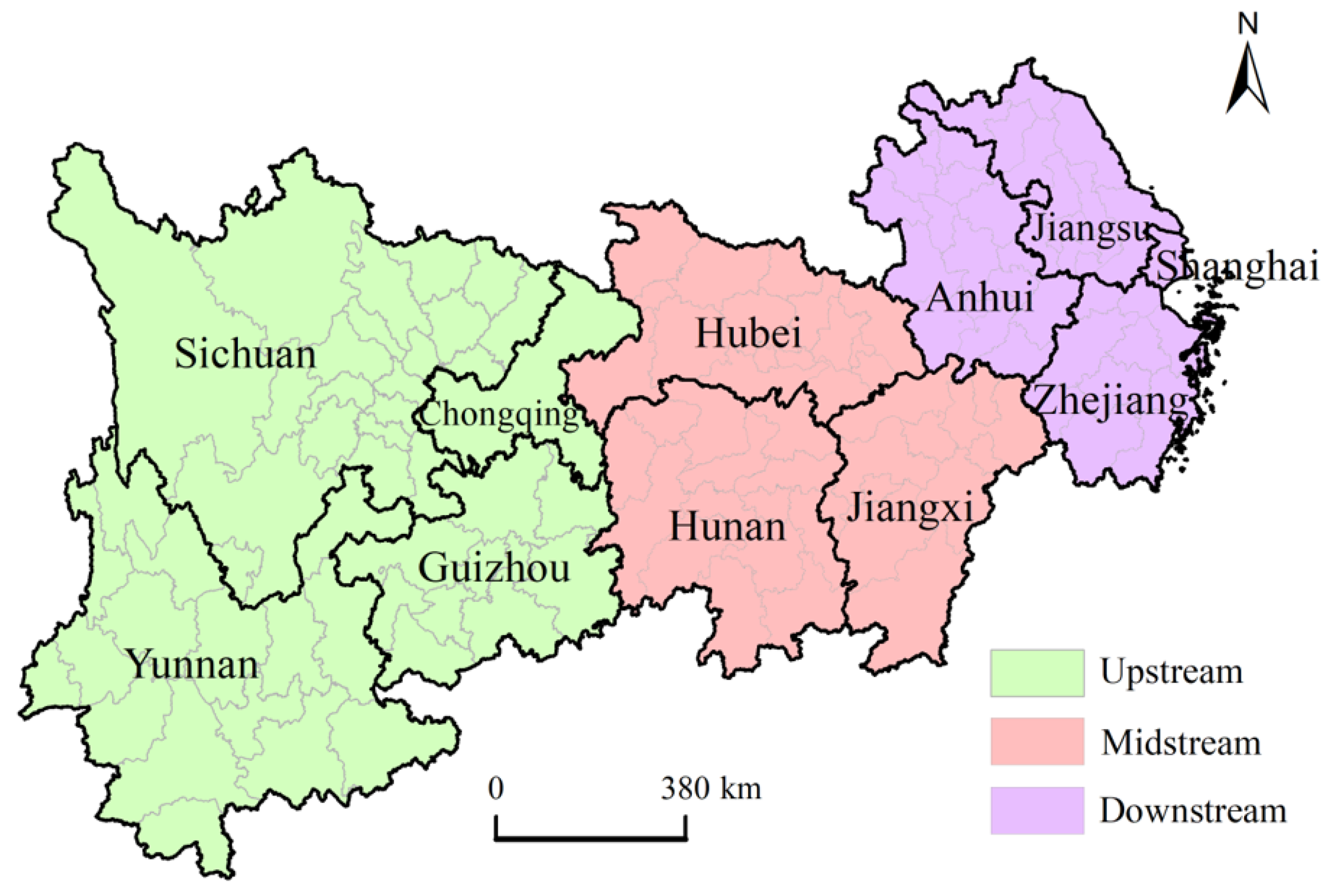
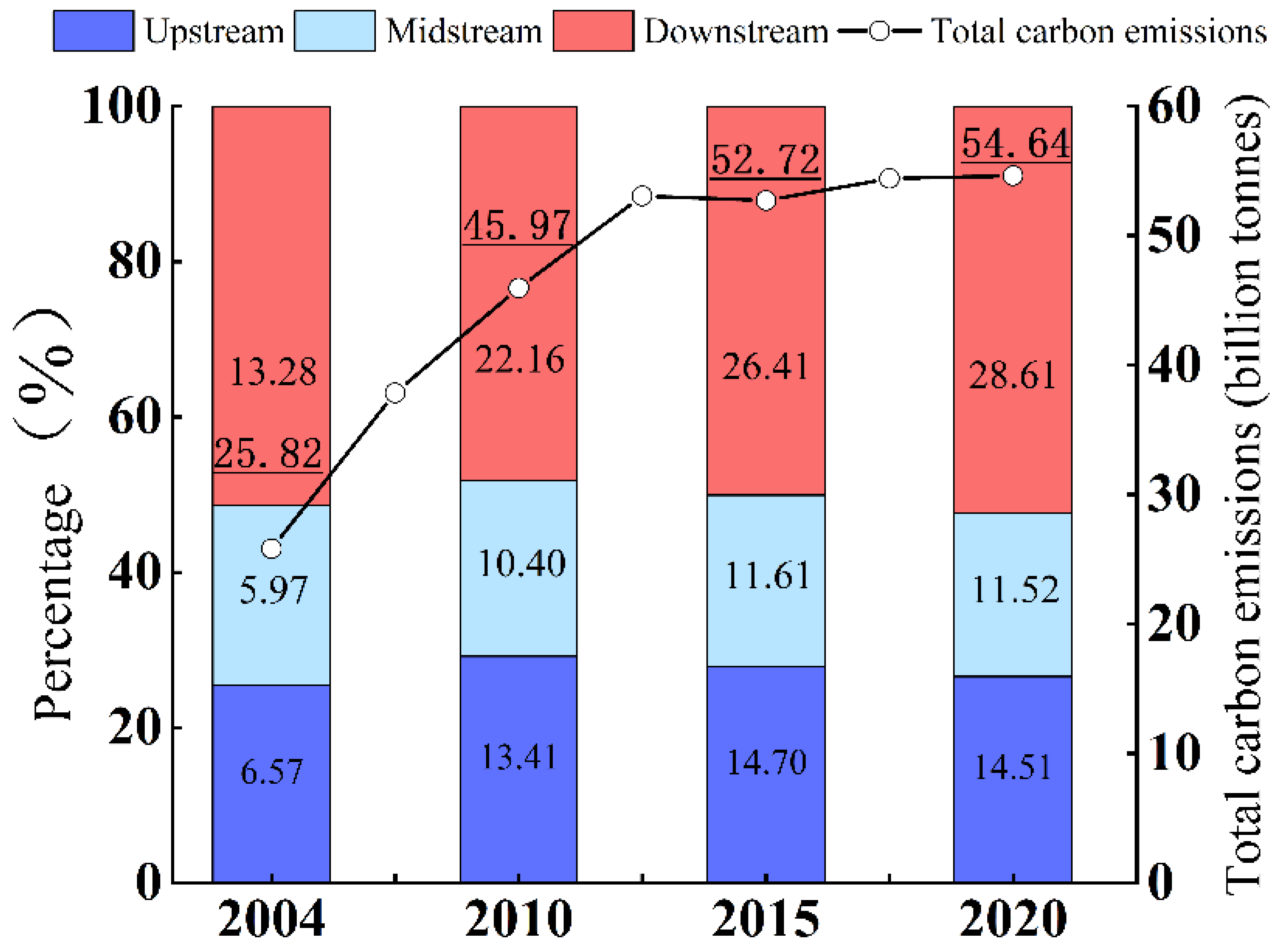
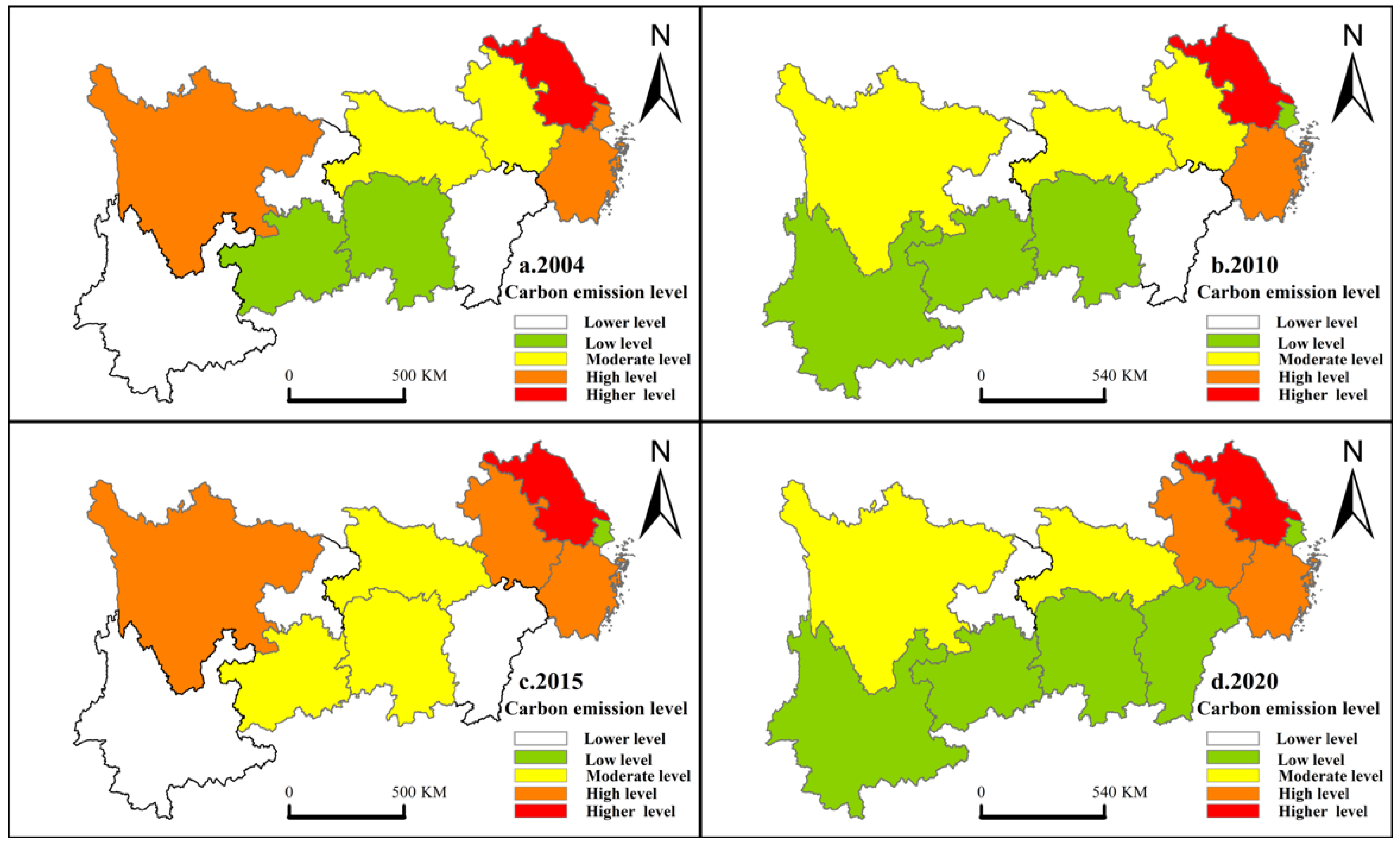


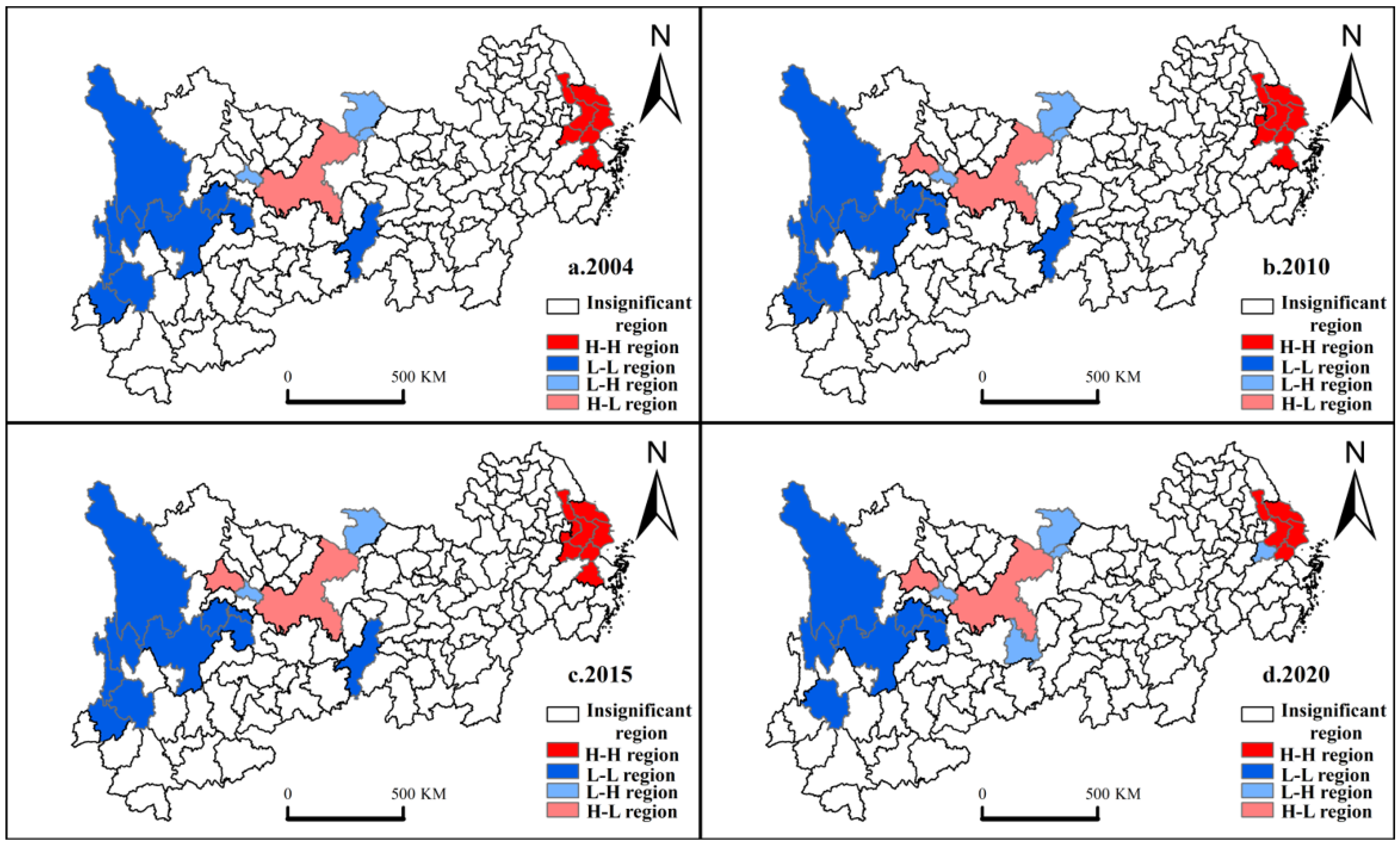
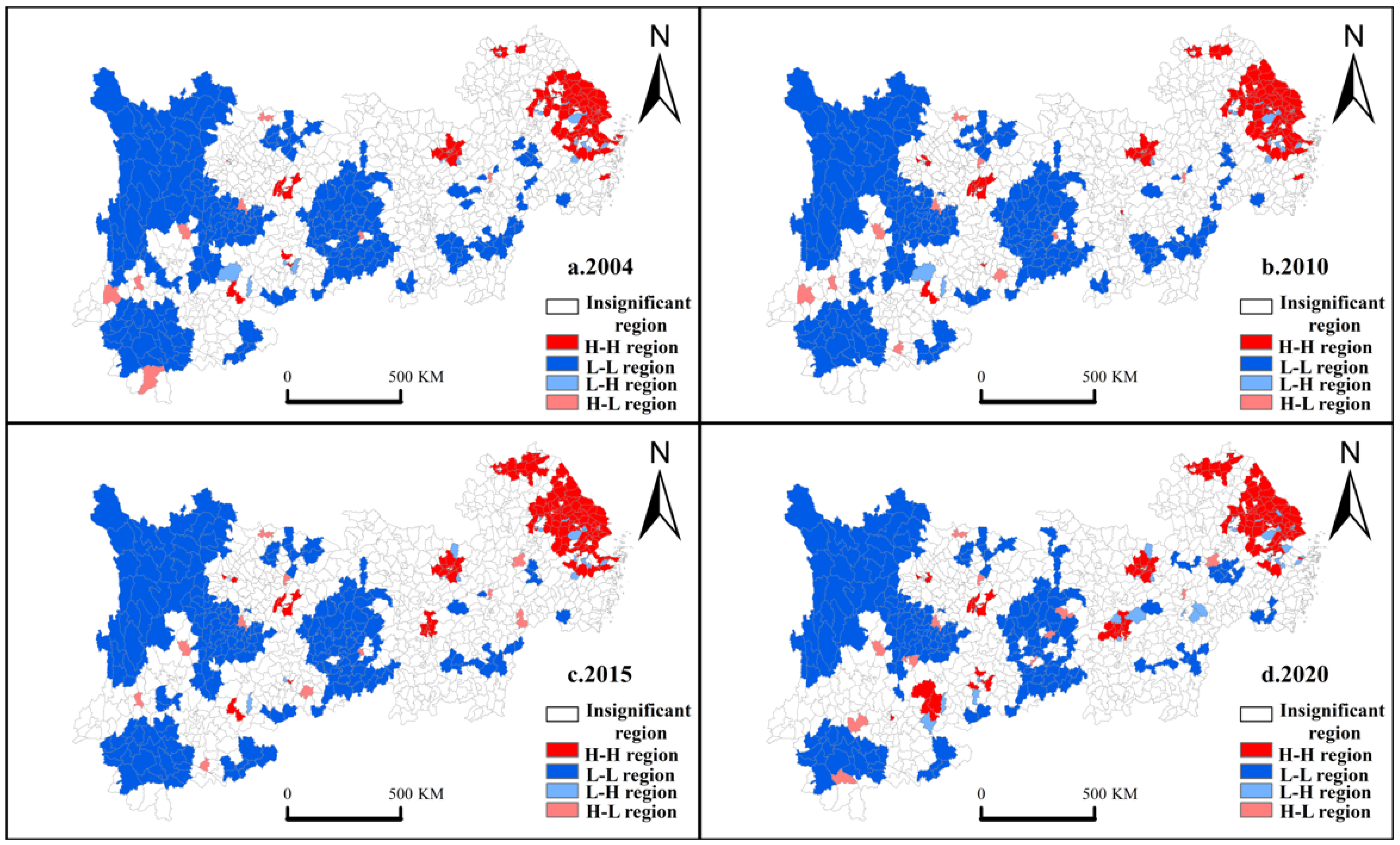
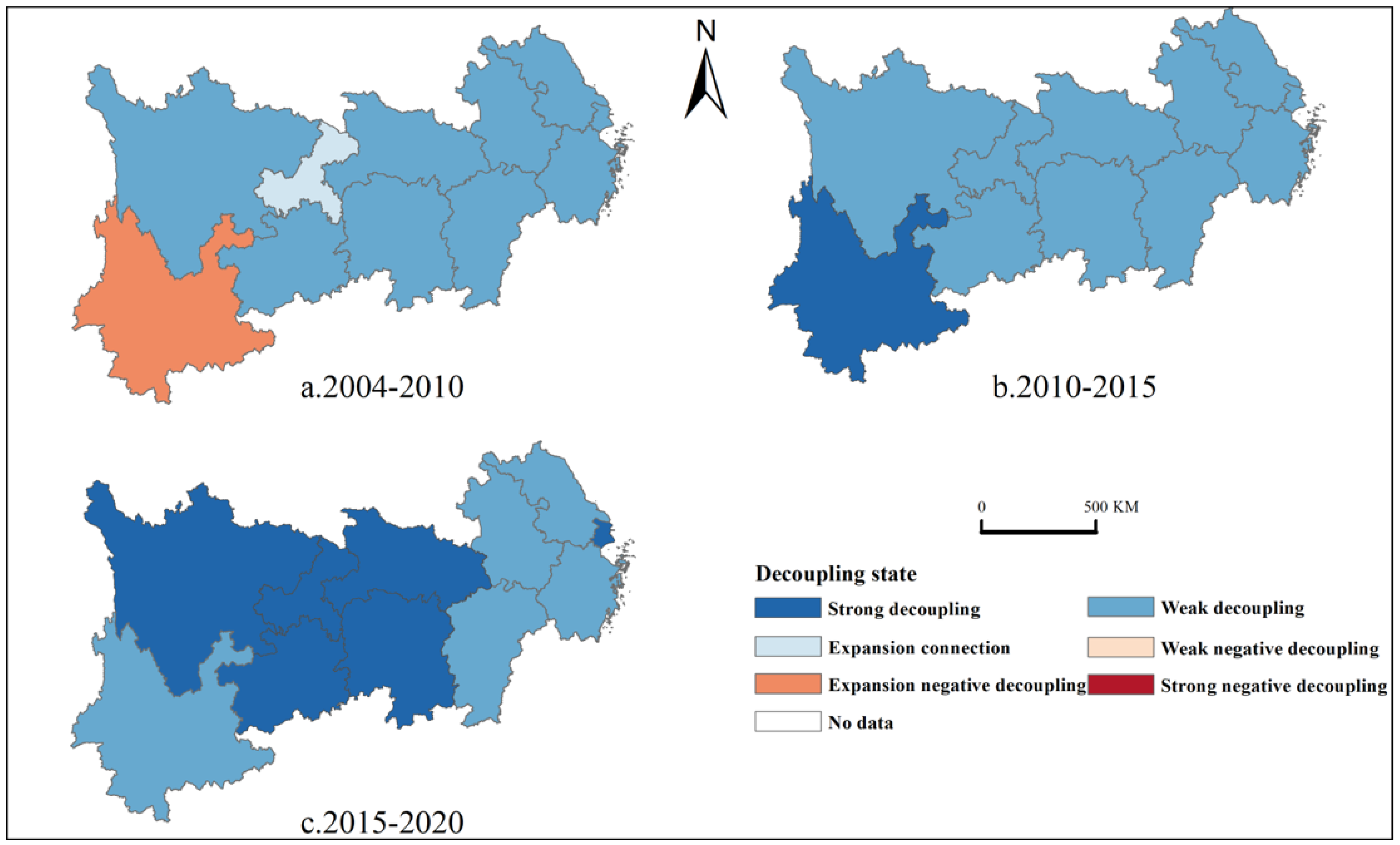

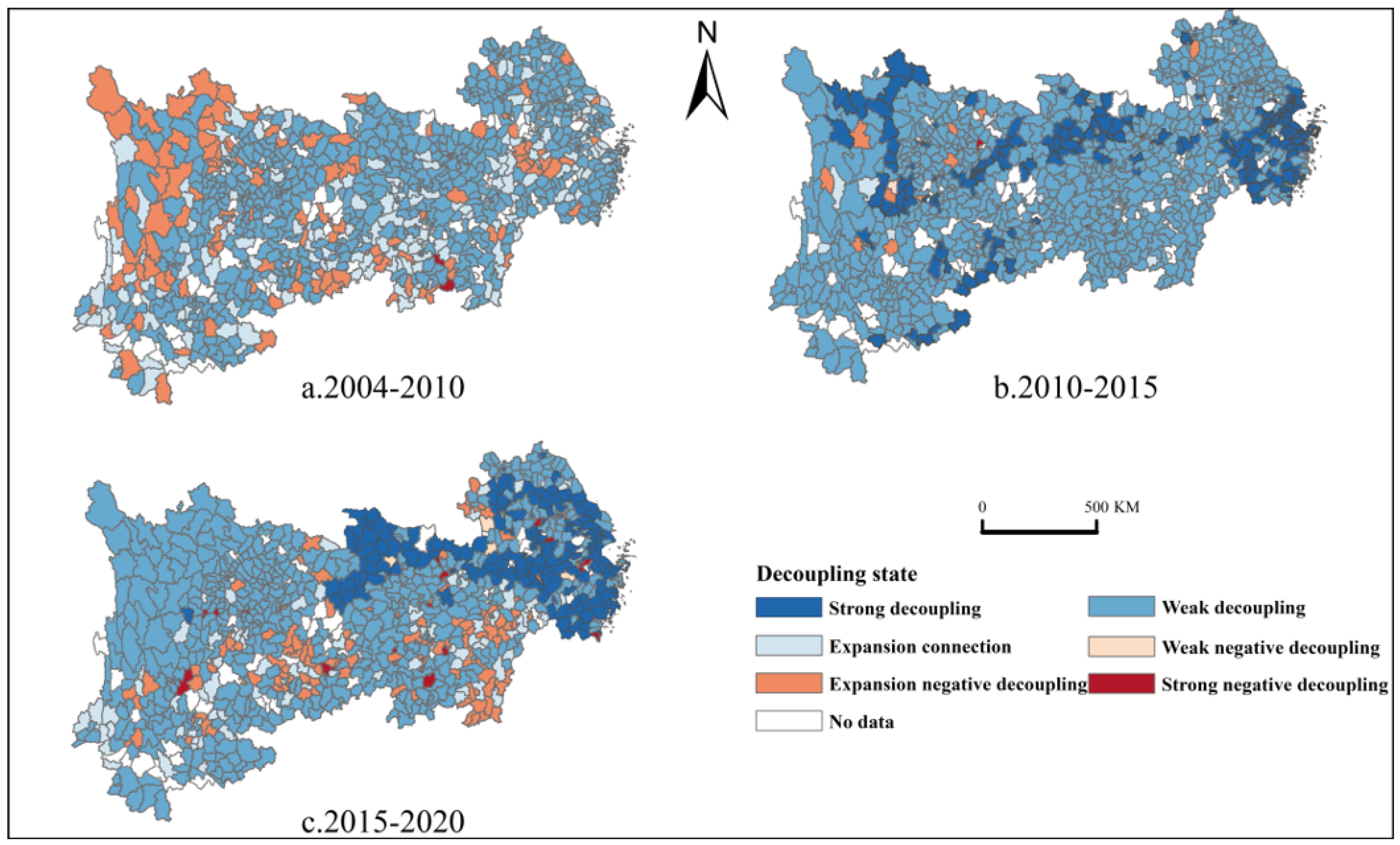
| Cities | Formulas | R2 | Cities | Formulas | R2 |
|---|---|---|---|---|---|
| Nanjing | 0.901 | Nantong | 0.971 | ||
| Suzhou | 0.944 | Changzhou | 0.944 | ||
| Wuxi | 0.929 | Taizhou | 0.956 | ||
| Xuzhou | 0.982 | Yancheng | 0.902 | ||
| Suqian | 0.939 | Huai’an | 0.961 | ||
| Lianyungang | 0.967 |
| Decoupling State | ∆C(t,t−1) | ∆G(t,t−1) | T(t,t−1) | Characteristics of Decoupling Types | |
|---|---|---|---|---|---|
| Connection | recession connection | <0 | <0 | 0.8 < T < 1.2 | C and G are decreasing at a comparable rate |
| expansion connection | >0 | >0 | 0.8 < T < 1.2 | C and G are growing at comparable rates | |
| Decoupling | recession decoupling | <0 | <0 | T > 1.2 | C is dropping faster than G |
| strong decoupling | <0 | >0 | T < 0 | C down, G up | |
| weak decoupling | >0 | >0 | 0 < T < 0.8 | C is growing faster than G | |
| Negative decoupling | weak negative decoupling | <0 | <0 | 0 < T < 0.8 | C is falling slower than G |
| strong negative decoupling | >0 | <0 | T < 0 | C up, G down | |
| expansion negative decoupling | >0 | >0 | T > 1.2 | C is growing faster than G | |
| 2004 | 2010 | 2015 | 2020 | ||
|---|---|---|---|---|---|
| Moran’s I | 0.1709 | 0.0217 | 0.0030 | 0.1189 | |
| Provincial | z | 1.5373 | 0.7657 | 0.7071 | 1.3680 |
| p | 0.0730 | 0.2220 | 0.2280 | 0.1110 | |
| Moran’s I | 0.1515 | 0.2174 | 0.2143 | 0.1163 | |
| Municipal | z | 3.5095 | 4.4692 | 4.2932 | 2.3751 |
| p | 0.003 | 0.002 | 0.002 | 0.002 | |
| Moran’s I | 0.4887 | 0.4955 | 0.4867 | 0.4264 | |
| County | z | 27.7486 | 27.5977 | 26.4841 | 23.3188 |
| p | 0.0000 | 0.0000 | 0.0000 | 0.0000 |
Disclaimer/Publisher’s Note: The statements, opinions and data contained in all publications are solely those of the individual author(s) and contributor(s) and not of MDPI and/or the editor(s). MDPI and/or the editor(s) disclaim responsibility for any injury to people or property resulting from any ideas, methods, instructions or products referred to in the content. |
© 2024 by the authors. Licensee MDPI, Basel, Switzerland. This article is an open access article distributed under the terms and conditions of the Creative Commons Attribution (CC BY) license (https://creativecommons.org/licenses/by/4.0/).
Share and Cite
Hu, H.; Wang, L.; Yang, M. Multi-Scale Analysis of Spatial and Temporal Evolution of Carbon Emissions in Yangtze River Economic Belt and Study of Decoupling Effects. Sustainability 2024, 16, 4222. https://doi.org/10.3390/su16104222
Hu H, Wang L, Yang M. Multi-Scale Analysis of Spatial and Temporal Evolution of Carbon Emissions in Yangtze River Economic Belt and Study of Decoupling Effects. Sustainability. 2024; 16(10):4222. https://doi.org/10.3390/su16104222
Chicago/Turabian StyleHu, Hang, Lei Wang, and Mingchen Yang. 2024. "Multi-Scale Analysis of Spatial and Temporal Evolution of Carbon Emissions in Yangtze River Economic Belt and Study of Decoupling Effects" Sustainability 16, no. 10: 4222. https://doi.org/10.3390/su16104222
APA StyleHu, H., Wang, L., & Yang, M. (2024). Multi-Scale Analysis of Spatial and Temporal Evolution of Carbon Emissions in Yangtze River Economic Belt and Study of Decoupling Effects. Sustainability, 16(10), 4222. https://doi.org/10.3390/su16104222





